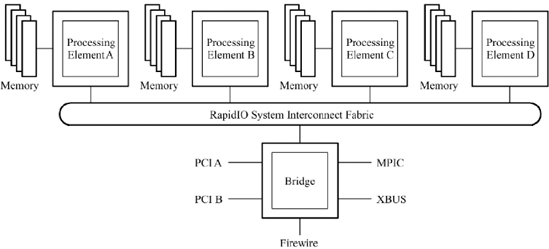3.1. PROCESSING ELEMENT MODELS
Figure 3.1 shows a simple example of a RapidIO-based computing system. This is a multiprocessing system where RapidIO is used to connect the four processing elements together with a single peripheral bridge element. The processing elements, in this system provide the following functions: processing, memory control and connection to a RapidIO interconnect controller. The bridge part of the system provides I/O subsystem services such as high-speed PCI interfaces, gigabit Ethernet ports, interrupt control, and other system support functions. In this example there are several memory banks, each associated with an individual processor. In a situation like this, the latency of the RapidIO interconnect is less critical to system performance as the processors are able to satisfy most of their data requirements from the directly associated memories.
Figure 3.1. A possible RapidIO-based computing system

Figure 3.2. Processing element example

Figure 3.2 shows an example of how a processing element might consist of a processor connected to an agent device. The agent carries out several services on behalf of the processor. Most importantly, it provides access to a local memory that has much lower latency than memory that is local to another processing element ...
Get RapidIO: The Next Generation Communication Fabric For Embedded Application now with the O’Reilly learning platform.
O’Reilly members experience books, live events, courses curated by job role, and more from O’Reilly and nearly 200 top publishers.

